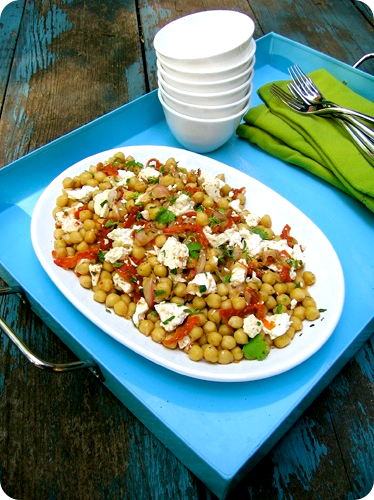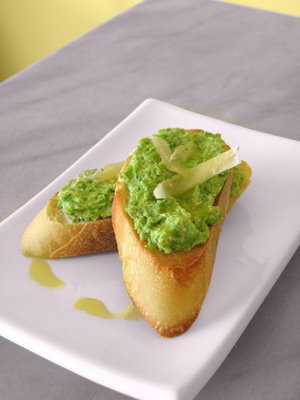Take me outside
 Friday, June 22, 2007 at 7:09AM
Friday, June 22, 2007 at 7:09AM 
I have come to embrace the fact that I'm a creature of habit. As such, I revel in my Pavlovian-impulse to make a beeline for a patio once the warm weather hits. In my mind, there is little better than some nibbles and sips under the sun during those muggy months of summertime. Conversation flows as evenings give way to starry nights that stretch on endlessly.
The only drawback to this tendency is that I only associate the al fresco lifestyle with restaurant dining. Save for a few backyard barbecues and poolside afternoons, I rarely eat outside at home - or at least, until recently.
It was most likely that coffee one morning, enjoyed on the back patio, that made me realize how much a simple change in environment altered the feel of the meal. All of a sudden, my morning cup seemed more of a treat than a ritual. It was as if I was on holiday, as my pace turned leisurely and I began to take notice of the trees above me and the birds all around.
Since then, we've been having our meals outdoors at every chance. Not just those meals prepared outside, but even those made in the kitchen are piled up onto a trays and taken to the patio, the deck or even to the porch step. Somehow, these meals feel an event; inherently festive as we all come together under a canopy of leaves.
Fitting for our verdant surroundings, this salad is full of vibrant colours and tastes. The red onion loses much of its harsh edge in a quick pickle of fragrant puckery vinegar, while jammy sundried tomatoes add another acidic but sweet note. They tumble together with meaty chickpeas and salty feta in a garlic vinaigrette, blanketed by a green shower of herbs. Twangy, sweet, creamy and satisfying, this is the sort of salad that is meant to be put in the middle of the table, allowing everyone to dive in.
Chickpea salad with sundried tomatoes, feta and a fistful of herbs
My own recipe. The fistful of herbs is literal; I head outside to our herb boxes and pick whatever needs pruning or strikes my fancy. Once I have a fistful, I know I have enough. One caveat, I have small hands.
Ingredients
1/4 large red onion, sliced wafer thin
2 tablespoons (30 ml) red wine vinegar
Salt
6 tablespoons (90 ml) olive oil
A good pinch, about 1/8 teaspoon, red chili flakes (optional)
1-2 cloves garlic, sliced wafer thin
8 sundried tomatoes, julienned
2 cups (500 ml) chickpeas (garbanzo beans)
1 teaspoon (15 ml) English mustard
Freshly ground black pepper
Approximately 1/2 cup (125 ml) of mixed herbs; examples include parsely, lemon thyme, coriander/cilantro, basil, oregano and mint
5 ounces (150 g) goats milk feta cheese
In a small bowl, douse the red onion with the vinegar. Sprinkle over a good pinch of salt, then use your fingers to squish the mixture a bit - this will work the salt into the onions and expedite the breaking down of their acrid bite. Set aside.
In medium saucepan over medium-low heat, warm the olive oil, garlic and red chili flakes. If there is any sizzle at all, turn the heat to low. Once the oil is fragrant and the garlic turns translucent, turn off the heat. Add the sundried tomatoes and chickpeas at this point, allowing them to steep as the oil comes to room temperature. This step of bathing the chickpeas in the warm oil is wholly optional, but I feel it imparts more flavour into the beans.
Once the oil has cooled, remove the tomatoes and chickpeas from the saucepan and put them into a large bowl (keep the oil, set it aside). Do the same with the onions, adding them to the salad but reserving the vinegar.
In that vinegar bowl, whisk in the mustard, salt and pepper. Whisking constantly, slowly drizzle in the steeped olive oil. Once the vinaigrette is emulsified and thick, coarsely chop the herbs and add to the bowl. Pour this dressing over the chickpeas and tomatoes. Toss to combine.
Crumble over the feta, then fold gently to distribute. Check for seasoning. Refrigerate for at least 2 hours for the flavours to combine. Can be served cold or at room temperature.
Serves 4-6.
Notes:
• Canned chickpeas are a convenient pantry staple, but dried beans (soaked, then cooked) will result in a better texture and are my preference.
• To make this a heartier meal, add chunks of grilled steak or chicken when combining the chickpeas and onions.
• Toss through some handfuls of arugula or other greens, then pile the salad onto slices of grilled bread for an appetizer.
• I have been toying with the idea of buzzing this salad in the food processor (with additional olive oil or maybe yogurt as needed) to make a spread. I'll report back on that - but if anyone tries it first, let me know.
 appetizer,
appetizer,  cheese,
cheese,  chickpeas,
chickpeas,  feta,
feta,  herb,
herb,  light,
light,  lunch,
lunch,  main course,
main course,  recipe,
recipe,  salad,
salad,  tomatoes,
tomatoes,  vegetables,
vegetables,  vegetarian
vegetarian 





















